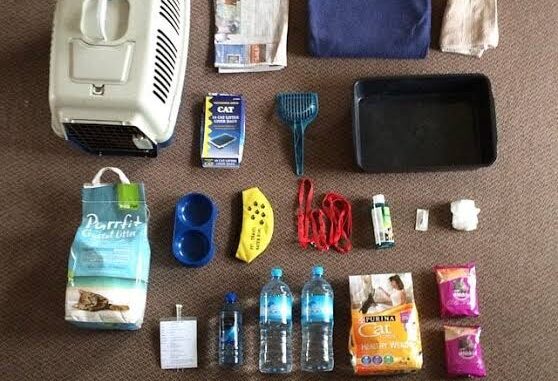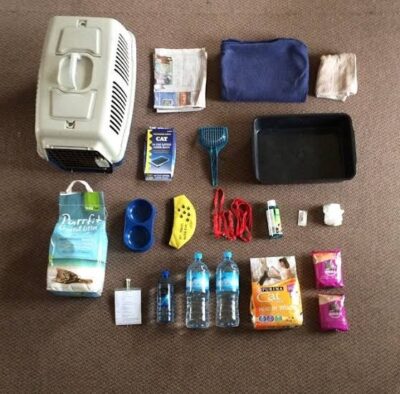
As a cat owner, you understand the importance of ensuring your feline companion’s safety and well-being at all times, especially in emergencies. Natural disasters, accidents, or even sudden health issues can arise unexpectedly, so having an emergency kit for your cat can make a significant difference.
This guide will walk you through the essential items for a cat emergency kit and provide tips on how to prepare for unexpected situations.

Why You Need a Cat Emergency Kit
Having an emergency kit for your cat is crucial for several reasons:
- Immediate Access: In an emergency, you may not have time to gather supplies. A well-prepared kit ensures you have everything you need in one place.
- Health and Safety: You can keep your cat’s health and safety a priority during stressful situations with the right medications, food, and medical supplies.
- Travel Convenience: Whether you’re evacuating or traveling, an emergency kit ensures your cat has the necessary resources to stay comfortable and safe.
What Should Be in a Cat Emergency Kit?
Here’s a comprehensive list of items to include in your cat emergency kit:
1. Identification and Medical Records
- ID Tags: Make sure your cat has a collar with an ID tag. If your cat is microchipped, confirm that the microchip information is up to date.
- Medical Records: Keep copies of your cat’s vaccination history, medical records, and any other important health information. This is especially important in case you need to evacuate to a shelter or seek medical attention.
2. Cat Food and Water
- Cat Food: Pack a minimum of 3-7 days’ worth of your cat’s usual food. If your cat has special dietary needs, make sure to include the appropriate food. Consider dehydrated or canned food that can be stored for longer periods.
- Water: Pack enough water for your cat to drink for several days. At least one gallon per cat, per day, should suffice.
- Food and Water Bowls: Make sure to include portable, easy-to-clean bowls for food and water.
3. Litter and Litter Box
- Litter: Keep a supply of your cat’s preferred litter. You can pack a small, portable litter box or use a shallow container as an alternative.
- Disposable Litter Bags: These will make cleaning up easier if you are in a confined or temporary living space.
4. Medications and First Aid Supplies
- Medications: If your cat requires any medication, make sure you have an ample supply. Don’t forget the instructions and dosage amounts.
- First Aid Kit: Your kit should include basic first aid supplies like:
- Bandages
- Gauze pads
- Antiseptic wipes
- Tweezers for removing splinters or ticks
- Adhesive tape
- Hydrogen peroxide (for cleaning wounds)
- Cotton balls and swabs
- Digital thermometer (for checking your cat’s temperature)
- Fleas and Ticks Prevention: Pack any flea and tick preventative treatments that your cat uses, as they can help prevent issues in unfamiliar environments.
5. Carrier and Harness
- Carrier: A comfortable and sturdy cat carrier is essential for transport and keeping your cat secure. Choose one large enough for your cat to move around but still feels secure.
- Harness: A well-fitting harness can be crucial for safely walking your cat outdoors, especially if you’re evacuating or have to leave your home.
6. Comfort and Familiar Items
- Blanket or Bed: Having something familiar like your cat’s bed or blanket can help calm your cat in stressful situations.
- Toys: A few of your cat’s favorite toys can help keep them occupied during an emergency or long evacuation.
- Familiar Scents: Pack a small item that smells like home (like your worn clothing or a familiar pillow) to comfort your cat.
7. Cleaning Supplies
- Wet Wipes: For cleaning up messes or wiping down your cat’s fur.
- Disposable Gloves: Useful for handling waste or cleaning up messes.
- Plastic Bags: For storing used litter or cleaning supplies.
8. Backup Supplies
- Flashlight: Essential if there’s a power outage.
- Batteries: Extra batteries for your flashlight, radio, or other electronic devices.
- Paper Towels: Handy for cleanup.
- Extra Collar and Leash: In case the first one gets lost or damaged.
9. Evacuation Information
- Shelter Information: If you need to evacuate to a shelter, find out which shelters are pet-friendly in your area and have that information available.
- Local Emergency Contacts: Include the contact information for your veterinarian and emergency pet hospitals.
- Map: A map of the area you can use to navigate in case of evacuation.
How to Store and Maintain Your Cat Emergency Kit
- Storage: Store your cat’s emergency kit in a waterproof container or a sturdy bag. Make sure it is in an easily accessible location.
- Rotation: Regularly check the contents of the emergency kit to ensure that medications are not expired and that the food and water are fresh. Rotate supplies as needed.
- Labeling: Label the kit clearly so everyone in your household knows where it is and what it contains.
READ ALSO: Essential Tips for First-Time Cat Owners
FAQs
How often should I update my cat’s emergency kit?
You should check your cat’s emergency kit at least every six months to ensure that all items, especially food and medications, are up-to-date and in good condition.
Can I use any carrier for my cat in an emergency?
No, it’s important to use a carrier that is sturdy and large enough for your cat to stand, turn around, and lie down comfortably. It should be well-ventilated and secure enough to prevent your cat from escaping during transport.
What should I do if my cat has a medical emergency during an evacuation?
If your cat has a medical emergency, contact your vet immediately or head to an emergency animal hospital. Keep a list of emergency contacts, including your vet’s number, in your emergency kit.
How can I make my cat feel more comfortable during a stressful situation?
Provide your cat with familiar items like their favorite toys, blanket, or bedding. Keep their environment as quiet and calm as possible. Some cats may benefit from pheromone sprays (like Feliway) to reduce anxiety.
How long should I prepare for?
A good rule of thumb is to prepare for at least 72 hours, but having enough supplies for up to a week is ideal. Adjust based on your specific situation and evacuation plans.
Leave a Reply
You must be logged in to post a comment.